Building total body strength and conditioning is no easy task. It takes time, effort, and consistency. Developing strong shoulders, hips, and knees can easily fill a twelve-month training program. Does that sound like a lot? It is. Enter the Get-up Ethos Program.
The get-up develops overall strength without you having to spend hours in the gym each day, moving from lift to lift, and completing varying loads and volumes. Making the get-up your primary lift, performing it daily, and sprinkling in a few other compound lifts for technique will see your numbers improve across the board.
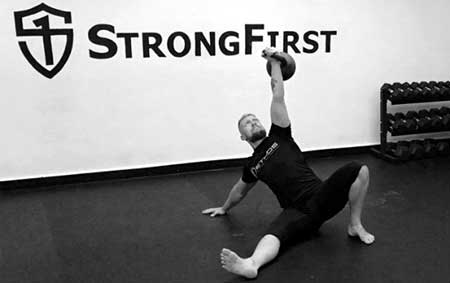
I used this program to help me press my half-bodyweight press at my SFG Level II Certification. Two days later, I performed a personal record get-up of 52kg and hit a new max in my pullups. This was after two days of hard training and testing at the Cert, air travel, and long days of coaching.
In the pullup, I was able to grip the bar harder, creating greater tension for my pulling power. In addition, I had the mobility and strength through my upper back to smoothly pull chest to bar. Both double-rack front squats and back squats felt tighter, with my ability to stay taller through my upper back and brace my abs harder being a noticeable difference. In short: everything felt better.
I received help in my SFG Level II preparation from StrongFirst Certified Team Leader Artemis Scantalides. Five days per week, I trained multiple get-ups with varying loads. The get-up had been something that I, and my athletes, had mostly performed as single reps. After months of the multiple get-ups and the results I saw, I began implementing this approach into my clients’ programming. In both one-on-one and small group test environments, improvements of movement quality, strength, endurance, and body composition have been noted, as well as increased understanding of movement competencies.
With these results, I have created the Get-up Ethos Program. Below you will see the exact plan, but first let’s go over some basics.
Why the Get-up?
From helping athletes move their bodies better to improving pullups, back squats, and beyond, the get-up teaches “kalos sthenos,” or “beautiful strength,” as well as movement competency and patience in droves. The get-up builds strong joints and muscles. With the variety of directions in which the get-up requires the body to move, the hips and shoulders learn to tie the body together as one fluid piece.
Repetition Proposition
The premise of this program is to do multiple get-ups in a row, without resting the kettlebell. You will perform one full get-up, bring the kettlebell back down to the supine position with your arm pressed, and then roll straight back to the elbow for rep two. And then three.
If the get-up offers all we say it does (and it does), why are we not using the way we use the other foundational lifts of swings, cleans, and snatches? Provided that form is dialed in, the function of the get-up can be repeated for greater results. Building now not only strength and mobility, but also conditioning due to the increased time under tension.
How to Progress Safely and Effectively
It can be tricky to progress any lift. Staying safe while increasing load, volume, and/or intensity is essential. But we can’t be so cautious that we never get any iron over our heads. The following program progresses accurately and safely to create gains across multiple other lifts.
The program assumes you can perform a single get-up on both arms, with form that meets the StrongFirst technique standards. If you are not able to do so, this is not the program for you right now.
The next assumption is that you are willing to dedicate a significant portion of every training session to the get-up for five days each week. As the saying goes, “If you want to press a lot, you must press a lot.” The same is true for the get-up. The bonus here is that you will also be able to press a lot (among other things) at the end of this get-up driven program.
How to Start
To begin, safely test your one-rep-max get-up. Get a spotter to help, employ the help of an SFG Instructor, or video your lift. If the lift looks bad, then it’s a no-rep. This 1RM number needs to be accurate to calculate your program percentages.
For the purpose of this article, I have assumed that 48kg and 24kg are the achieved 1RM for men and women respectively. This may be off for you, and if your 1RM is below 16kg, then your time will be better spent dialing in your technique with practice of single repetitions.
If your 1RM is different from left to right, choose the lower of the two and train the same percentages on each arm. This will go some way to helping you even out the imbalance.
The Method
- Phase 1: Practice—Weeks #1-4 are the practice. You’ll get acclimated with the sheer volume of the movement. Grip, wrist pressure, and shoulder stabilizers must acclimate to the rigors of increased density safely and without exhaustion. Leave your ego at the door and stick to the plan.
- Phase 2: Accumulation— Weeks #5-6 work on volume. Here you will accumulate more overall tonnage and movement. Recovery and nutrition will aid in your progress.
- Phase 3: Mass—Weeks #7-12 focus on increasing the mass per single lift. The total amount of load as well as the average load per lift is noted below in the prescription.
The Get-up Ethos Program

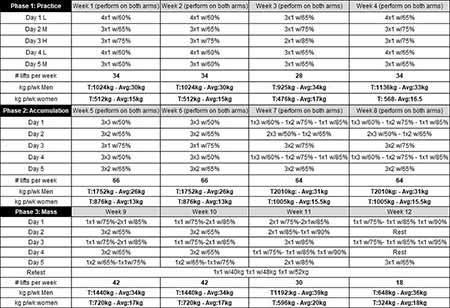
CLICK HERE TO DOWNLOAD THE COMPLETE EXCEL SHEET
Although this may look like a complicated cycle, it is actually quite straightforward. If your 1RM is not 48kg, then it will take a little deconstructing to determine your percentages per lift. Should you hit a wall, it is fair to assume that taking a few days off will help you reset and recover. There is no denying this is a lot of work.
“Rome wasn’t built in a day. But they were laying bricks every hour.”
Complementary Lifts
The rest of the program takes a simple complementary approach. A smattering of squats, presses, rows, carries, and swings over the course of the week will do the trick. My general weekly program structure looks like this:

What to Expect from Training Multiple Get-ups
Watch your grip and forearm strength improve dramatically. Upon completing this program, it felt as though my hands had grown (being that I am a thirty-year-old male, this is unlikely to have actually happened). After twelve weeks, my palms felt like cast-iron skillets and my forearms like concrete pillars.
This had huge carryover into the rest of my training. I experienced significant gains in my pullups and squats, increased mobility in my back, and a greater work-load capacity. With adherence to this program, you will no doubt find similar results.
Final Considerations
Before starting this program, understand the standards, requirements, and time commitments. Have an SFG Instructor look at your technique before you embark down a road with anything out of place.
Recognize that missing a day of training is not a deal-breaker by any means, but this program does require significant time with a kettlebell in your hand.
Once you have committed yourself, stick to the plan. Trust and respect the process of learning along the way. I recommend taking notes during and at the end of each training session that focus on things you learned about the lift—the nuances, details, and minutia—on your road to mastery of “kalos sthenos.”
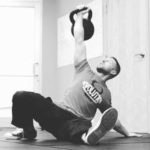

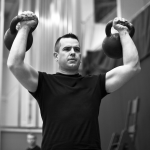
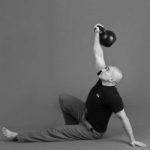


Loving this program, in my third week. I’ve always been slightly intimidated by get-ups, but doing them 5 days/week is really helping me get past that. Just wondering, once I increase my 1RM at the end of 12 weeks, is it okay to repeat the whole 12-week program, bumping up my kb weights accordingly, to go after a new, increased 1RM? Thanks so much for sharing your great program.
Lynn,
I am really glad you are enjoying the program. I am excited for you to make big gains through its implementation. With regards to repeating the program, you absolutely can. However, it is definitely wise to take a deload cycle. After 12 weeks of anything, get-ups included, your central nervous system will need a rest and some time to recuperate. take some training days off, play with some different lifts, keep them light, keep them fun, keep them varied. get your body moving in a few different patterns before going back to the same ones again. 24 weeks is a long time to be following one set of lifts, no matter how dynamic they may be. hope this helps and keep me updated on your progress. Power to you!
Jay, what rest intervals would you recommend between the get up sets especially the 3×3?
Thanks, Jim
Jim, both for myself and the athletes using this program there was “no planned rest”. I simply allowed time for adequate eniughbrecovery that the following set/rep would not be hampered by excessive fatigue and heavy breathing. With this in mind I’d say 1-2 minute should be sufficient. Hope this helps.
Jay,
Would performing 1HS every day with this program be too much in your opinion? As in, Halos, Goblet Squats & 1HS with a moderate weight to GTG, so to speak, while following this program.
Respectfully,
Michael
Michael,
This is a fine compliment providing the sets, reps and load stays moderate. 5 sets of 10R/10L with a “working weight” would be more than adequate.
Hope this helps.
I enjoy doing the S & S routine 2-3 times a week, if using your propose get up program, should I hold off on doing the S & S until the completion of the get up program, or can I incorporate it?
Dan,
Looking at the program in S+S, the weight jumps from 32kg to 40kg, which can be quite a progression. As stated in the book, the protocol given should not be followed blindly. So in this instance if you are struggling to make progress with the S+S protocol, YES, I would consider replacing this with my approach, making smaller jumps and accumulating more tonnage over a longer period of time. Hope this helps.
James,
I’m excited to start this protocol, but have a question about a warm-up for this. What would you recommend: S&S style warm-up, a few lighter Get-Ups, going straight at it?
Thanks,
Gus
Gus,
I’m excited for you to get stuck into the program. With regards to warm up, I checked my training logs and I performed:
Armbars, single leg hip bridges and some low volume GTG (grease the groove) pull-ups one day and: squat pry, push-ups, and again arm bars on squat/knee dominant days. Really getting the hips and shoulders loose is the plan. Hope this helps and let me know how it goes.
That’s awesome, James, thanks for the reply.
I just started PTTP, any chance they could be ran together?
Hey Ben,
I have little experience with Power To The People, so I could not say for sure. However, my inclination would be to say not. I have no doubt that Pavel programmed the get-up specifically for PTTP so attempting to blend the 2 would be difficult, to say the least.
This is great! Thanks Jay!
Glad you enjoyed it Rich!
As someone who has struggled to make the jump from 32 to 40 kg this programme looks ideal.
Great article.
Just one question for clarification 3×1 refers to one set of 3 continuous reps?
Karl, gladbyou enjoyed the article. Through out the program the sets come first then reps (sets x reps). So in phase 1 you’ll only be doing single reps all 4 weeks.
Hope this helps.
I was wondering if you could comment on using this program to progress your S&S working weight vs. following the traditional S&S progression scheme. I am currently comfortable at 24 kg, but the last time I made a run at 32 kg (following S&S progression), I started getting sore shoulders (likely tendinitis or impingement). Might this be a “gentler” way to manage the progression and get those shoulders more stable under the higher weight?
John,
Absolutely. Time under tension is just another variable (load, volume, intensity etc.) to be tweaked and with regard tot he get-up, where a well-performed rep can take 35-45 seconds, repetition of the pattern at a lower load, increasing time under tension is a great way to groove the sticky pattern you may be hitting in your attempt at the 32kg. I would also recommend using in the armbar to help mobilize and stabilize the shoulder for efficacy. I wrote about this in my first article for SF you can find it here: http://www.strongfirst.com/arm-bar-day/ hope this helps my friend.
One thing I’ve found is I can hold a KB and a small DB in one hand
I’m no instructor and no expert, just something that has worked for me
Great article. Can you clarify that where the table says 3×2 w/65% this is 3 sets of 2 reps and not 3 reps for 2 sets?
David,
3 sets of 2 reps (2 in a row). This is the same for all the other written sets/reps in the program.
Hope this helps.
Great article! What kind of load, volume and rep scheme are you recommending for the accessory work? Thanks in advance!
Rob,
I worked an “easy strength” style plan of 5×5 @75-85% for most of my accessory strength drills. This is what I would call my working weight. Some days I would go lighter and some I would push it depending on how I felt, but whatever I did was not to interfere with my getup practice for the next day.
Hope this helps.
Great article! Thanks for that!
Honestly, you could have made a whole book out of it (include exercise descriptions, mobility, nutrition) and sold it. Instead, you shared it. Noble move!
Great article Jay!
Thanks Evan!
Thanks for the article. What does the “L”, “M” & “H” next to the phase 1 days indicate? Thank you.
L = light, M = medium, H = heavy
You’re welcome Eric. As Evan notes below, L, M, H stands for light, medium and heavy. Hope this helps.
What I do is:
In my regular Simple & Sinister practice I use a heavier bell and alternate arms every rep for my get ups.
On my “die but do”-day I use a lighter bell for both get ups and swings. I do five straight repetitions with my left arm before switching to the right (doing the same). This happens no more than once a week. Longer time under tension with a lighter bell.
Programming so simple I make Pavel proud 🙂 (I hope).
A great way to build increased time under tension without having to do a lot of overhead pressing. Good work.
The TGU’s are great, no doubt.
My feedback would be there are a lot of different size bells needed.
Mine are in half pod increments rather than 2 lbs increments. I already have quite a few which should be enough for any program without breaking the percentages down further.
Thanks for putting the program together and your passion to inspire others for fitness.
Dennis,
Yes this program calls for access to a full variety of bells to compete well. With smaller adjustments over time the progression from 1 bell to the next can be better managed. Maintaining the standard of the movement and safety of the athlete is paramount. Larger bell jumps increase the risk of fatigue and breakdown.
It is also important to note that this programs end purpose is to increase 1RM. Close to maximum the increments of increase in weight need to be minor to avoid failure and breakdown. In this case I like to refer to he max effort attempt of an Olympic weightlifter who may work for years to increase their 1 rep max by just a couple of pounds. It is just lucky that they can add small plates, and don’t need a completely new bell. One of the few draw back of the kettlebell I guess.
My suggestion for bridging the gap with the array of bells you have, would be to simply attempt this program with the bells closest to the recommended percentages in the table above.
Hope this helps.
I find the get up to be a little “alternative lifestyley” for my own training but think it’s wonderful nonetheless. really like the concept of the single leg dl written about in a previous article tho and find it a helpful addition.
John, ‘Alternative Lifestyley’ is the funniest thing I’ve heard all day! I can’t wait to throw it out myself!
John,
I get it. It’s not a foundational “big 3”. I like a heavy deadlift as much as the next guy. However I think for athletes and gen pop clients alike, the getup is the thread that ties he pieces of movement and strength together. Nothing teaches movement under tension like the getup. Akin to breakdancing with a cannonball, we are beginning to see NFL strength and conditioning coaches substitute the bench press for the get up for improved movement capacity, balance and stability in addition to strength.
I like this because it’s a programme focussing on the getup and doesn’t take long nor does it get caught up in cardio concerns, which many of us are getting elsewhere than in weights (not that getups don’t get you heart rate up!)
Glad you like it Kozushi.
Jay, do you recommend any particular work:rest ratio?
Rick, good question. No. Rest as much as needed. The getup shouldn’t be rushed and if you’re gasping for breath beneath the bell that’s going to get rough. So rest as much as needed. I’d likely take shorter rest in single reps and longer rest between sets of 3.
Hope this helps.
Well written article, staying with basics. Pretty intimidating exercise for some people, but the rewards, as stated, are immense.
Absolutely Eric. Glad you like the article.
Jay
Nice work on your article I program. I could not agree more, everyone should be doing TGU’s.
The get up was the first move I did each day in my IM program, with waving the load with the goal of the 24kg being my go to weight to press over head with zero warm up. And it is still in most every program I write even if just the warm up.
Yes, get-up is a good wakeup.
Karen,
Thank you. Found the get up to be the driving force behind the 1/2 bodyweight press success. Even now in our personal and group training plans for next months TSC the getup features heavily.
Glad you liked the program hope it can help some people hitnsome new PR’s across the board.
Very interesting plan, I’ve moved away from the barbell to BW / KB work for now due to repeated injuries from bad movement quality, I might need to give this a try